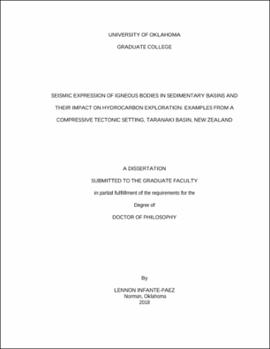| dc.contributor.advisor | Marfurt, Kurt J. | |
| dc.contributor.author | Infante-Paez, Lennon | |
| dc.date.accessioned | 2018-05-16T14:28:05Z | |
| dc.date.available | 2018-05-16T14:28:05Z | |
| dc.date.issued | 2018-05-11 | |
| dc.identifier.uri | https://hdl.handle.net/11244/299929 | |
| dc.description.abstract | The impact of Neogene volcanism on hydrocarbon exploration in the Taranaki Basin, New Zealand remains under-explored. To better understand these effects, I performed detailed seismic interpretation coupled with examination of data from exploratory wells drilled into andesitic volcanoes. I discovered that igneous bodies can mimic the seismic expression of common sedimentary exploration targets such as bright spots, carbonate mounds and sinuous sand-prone channels. I find that by understanding the context of volcanic systems, one can avoid misinterpreting them as something else. Important clues that help distinguishing volcanoes from carbonate mounds in seismic data are not in the actual mound-like reflectors, but rather in features around and below these ambiguous facies. These clues are the disruption of reflectors immediately below volcanoes and igneous sills forming forced folds nearby and below the volcanic edifices. Secondly, in good quality seismic surveys, volcanic rocks of intermediate magma composition (andesitic) present distinctive patterns in seismic data. Such patterns are easy for machine learning to identify using a combination of seismic attributes that highlight the continuity, amplitude and frequency of the reflectors at the same voxels. Clustering of these seismic attributes using Self-Organizing Maps (SOM) allowed for the identification of different architectural elements such as lava flows, subaqueous landslides and pyroclastic flows associated with the andesitic Kora volcano. Finally, by 3D mapping of the Eocene, Miocene and Pleistocene strata in the Kora 3D seismic survey, I reveal that the andesitic volcanoes are capable of large structural trapping (Mega forced folds) in both the strata predating and postdating the volcanism. These traps are four way-dip closures with the potential to store more than 1.0 billion of barrels of oil if filled to spill point. | en_US |
| dc.language | en_US | en_US |
| dc.subject | Geology and Geophysics, Seismology | en_US |
| dc.subject | Seismic Interpretation | en_US |
| dc.subject | Volcanics | en_US |
| dc.subject | Machine Learning | en_US |
| dc.title | SEISMIC EXPRESSION OF IGNEOUS BODIES IN SEDIMENTARY BASINS AND THEIR IMPACT ON HYDROCARBON EXPLORATION: EXAMPLES FROM A COMPRESSIVE TECTONIC SETTING, TARANAKI BASIN, NEW ZEALAND | en_US |
| dc.contributor.committeeMember | Slatt, Roger | |
| dc.contributor.committeeMember | Pigott, John | |
| dc.contributor.committeeMember | Davegowda, Deepak | |
| dc.contributor.committeeMember | Wallet, Bradley | |
| dc.date.manuscript | 2018-05-11 | |
| dc.thesis.degree | Ph.D. | en_US |
| ou.group | Mewbourne College of Earth and Energy::Conoco Phillips School of Geology and Geophysics | en_US |
